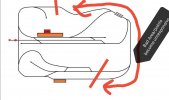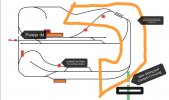duncan1_9_8_4
UK Railway Signaller and Garden Railway Operator
Here goes. I currently use a CS3 to power my railway. All has been fine, until today. The problem I have is, the points via massoth modules work fine, or the locomotives work fine. But not both. If I run a locomotive, the points become unresponsive. So I reset, and again, the points OR locomotive work fine, but the points fail to be responsive upon moving a locomotive. In adition, the two street lights I have connected to the track, start to flicker, but not until the locomotive moves.
I have recently installed a level crossing with concrete up to each rail, but not in between the rails. Could this somehow be affecting the electrics while the cement is damp? And will it cure when dry? I have seen lots of examples of cement level crossings on garden railways, so did not think any problems would be caused?
I have recently installed a level crossing with concrete up to each rail, but not in between the rails. Could this somehow be affecting the electrics while the cement is damp? And will it cure when dry? I have seen lots of examples of cement level crossings on garden railways, so did not think any problems would be caused?


